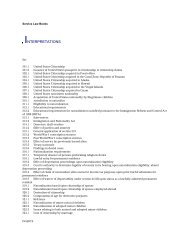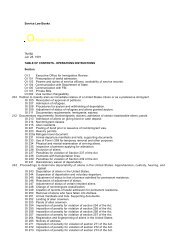You also want an ePaper? Increase the reach of your titles
YUMPU automatically turns print PDFs into web optimized ePapers that Google loves.
<strong>Inspector's</strong> <strong>Field</strong> <strong>Manual</strong><br />
completed. This procedure may vary somewhat at different ports.<br />
If a crewmember does not have an I-95, or has obtained a new passport, the inspector should prepare and execute<br />
a new I-95 and staple it in the passport, adjacent to the "D" visa. He or she should also conduct a lookout query in<br />
IBIS whenever an I-95 is issued. For the I-95, a "D-1" stamp and line stamp are used, not the regular admission<br />
stamp. If no line stamp is available, the inspector will enter the date, stamp number and his or her signature in<br />
the space for the line stamp. At major airports, the I-95 is not stamped on the reverse at each subsequent entry,<br />
since crewmembers may be encountered many times each month.<br />
If a crewmember with an expired passport or visa is encountered, a visa waiver, passport waiver, or refusal of<br />
admission, as described in Chapter 23.3, may be considered.<br />
(c) U.S. Citizen and Resident Alien Crew. U.S. citizen crewmembers must have a valid passport only if arriving<br />
after travel outside the western hemisphere. Resident alien crewmembers may travel on Form I-551. Resident<br />
alien crew ordinarily would not be employed on the same flights as "D" crewmembers. Do not stamp passports<br />
of U.S. citizens or returning resident crewmembers unless asked to do so.<br />
(d) INSPASS and crewmembers. The INSPASS inspection process is also available to air crew. This means that<br />
some crew will not be inspected in the regular crew booth. Verify through Customs that crew members who<br />
were not inspected in the crew booth submitted a Crew Customs Declaration at the crew Customs booth.<br />
(e) "Deadheading" Crew. "Deadhead" crewmembers are air crew members who enter as passengers or<br />
non-working crew on board a regular flight or "positioning" aircraft. They are generally entering solely for the<br />
purpose of joining the working crew of an outbound flight. Although ordinarily a C-1 visa is appropriate in<br />
such circumstances, a B-1 visa is also permitted. At some ports, such crewmembers may be added to the<br />
general declaration and admitted as D-1. In all other circumstances, working crewmembers may be classified<br />
only as D-1 or D-2.<br />
22.6 Processing Arrival Manifests and Flight Logs.<br />
(a) I-92/I-94. Once the last passenger from the flight has been cleared, complete the citizen/alien counts on the<br />
I-92. The alien count will be the tally of all Forms I-94 (regular, TWOV, VWPP, including refugees, parolees and<br />
secondary referrals) collected for the flight. The citizen count includes U.S. citizens, alien residents, immigrants<br />
and any nonimmigrants who do not require an I-94. (This includes Canadian nationals, aliens having a<br />
common nationality with nationals of Canada or with British subjects in Bermuda, Bahamian nationals, British<br />
subjects resident in Bahamas, Cayman Islands, and Turks and Caicos Islands.) The I-92 should also contain the<br />
number of U.S. citizen and alien crew inspected. After the flight count has been finalized, re-sort Forms I-94,<br />
segregating those for F-1, M-1, TWOV, VWPP and departure. Bundle remaining I-94 forms with the I-92 for the<br />
flight.<br />
Forward all Forms I-94 and I-92 for data entry as described in Chapter 22.7.<br />
(b) I-577. Every INS airport inspectional facility is required to maintain a Daily Air Passenger Inspection Log,<br />
Form I-577, containing key information about each arriving aircraft. Most often, this is maintained in the crew<br />
booth or secondary area by the crew inspector, secondary inspector or supervisor. The log contains key<br />
information concerning the passenger load, arrival and inspection times, and number of inspectors assigned.<br />
[See airline codes in Appendix 22-2.] A complete, accurate log is necessary, since the Service is often required to<br />
respond to inquiries regarding flight delays and manpower on duty. Frequently, you will be required to<br />
process more than one flight simultaneously, somewhat complicating obtaining the flight opening and closing<br />
times. Enter flights on the log in order of arrival, to the extent possible. Ports with multiple terminals or<br />
separate cargo facilities may maintain multiple daily logs. Flights are generally expected to be cleared in less<br />
than 45 minutes. Mark the flight log, in the left hand margin, "DLY" whenever passenger inspection exceeds 45<br />
minutes. In addition, follow local procedures for adherence to the national policy for reporting such delays or<br />
other unusual situations affecting the inspection. Do not include clearance times for large groups of TWOV<br />
passengers or refugee groups in the passenger processing time for a flight. Note that the first passenger time<br />
(FIRST PAX) time on Form I-577 should be the time that the first passenger enters the inspection room and not<br />
when the flight paperwork is presented to the crew inspector. If the passengers are detained on the aircraft due<br />
to congestion in the inspection area, add to the inspection time the minutes elapsed between blocking and the




